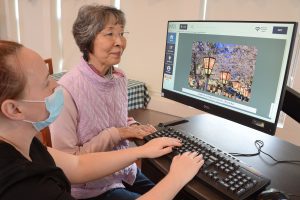
Alzheimer’s disease is the most common form of dementia. As a brain disorder that affects memory, language, reasoning, judgement and behavior, Alzheimer’s is characterized by multiple symptoms, including disorientation and wandering.
What is Wandering?
When a person with Alzheimer’s disease or other form of dementia becomes disoriented, they may not be able to recognize familiar faces or places. They may become confused about the time of day, or even year, and forget where they are or how they got there. Essentially, wandering is when someone with dementia is looking for something or somewhere in their past, and or something that they must do, such as go to work, or find their children.
Although common in people with dementia, wandering can be dangerous, even life-threatening, especially during extreme weather or if it occurs in a secluded area. When a person wanders, they can be hard to find because they often act unpredictably. They may not call for help and may not remember their name or where they live.
Who is at Risk for Wandering?
Everyone with Alzheimer’s disease or other forms of dementia is at risk for wandering. Approximately 60% of people living with dementia will wander, and many do so repeatedly. Wandering can occur at any stage of dementia, even the early stages, and even if someone has never wandered before. Although not statistically proven, men seem to be at a slightly higher risk for wandering than women.
What Causes Wandering?
Disorientation and confusion are the main cause of wandering, but there are several reasons why a person with dementia may wander. Crowds, new places, restaurants and shopping malls can cause anxiety for people living with dementia, and trigger wandering. They may wander as a result of searching for past friends, or trying to perform an old routine, such as going to work or shopping. Even attempting to fill basic needs can lead to wandering, such as looking for food, trying to find a bathroom, or simply wanting to go outside.
Warning Signs of Wandering
If you are a dementia caregiver, it’s important to recognize the following warning signs that your loved one may be at risk for wandering.
- Becoming restless, making repetitive movements, or pacing
- Acting as if they are performing a task, but not actually doing it
- Trying to “go home” when they are already at home
- Getting lost or confused on the way to the bathroom, kitchen, bedroom, etc.
- Talking about “going to work” or fulfilling other former obligations
- Asking about past friends and family
- Taking longer than normal to return from a walk, drive or errand
How to Prevent Wandering
 When someone is at risk for wandering, caregiving can become an around-the-clock responsibility, and memory care communities are the safest place for your loved one.
When someone is at risk for wandering, caregiving can become an around-the-clock responsibility, and memory care communities are the safest place for your loved one.
Unlike an assisted living community, memory care communities have staff that are specially trained to care for and redirect people with dementia. In addition to 24-hour care and assistance with daily tasks, memory care communities provide activities designed to support socialization and stimulate cognitive abilities, and they are secured to prevent wandering.
Read: When is the Right Time for a Memory Care Community?
Memory Care near Albany, Saratoga & Glens Falls
Eddy Senior Living is committed to improving the quality of life for individuals living with Alzheimer’s disease through innovative memory care in a warm, homelike environment. We offer specialized memory care at the Marjorie Doyle Rockwell Center in Cohoes, the Eddy Memory Care Community at Eddy Hawthorne Ridge in East Greenbush, and The Glen at Hiland Meadows Memory Care Community in Queensbury NY opening in the fall of 2022. To schedule a tour, contact us or call (518) 280-8385.
